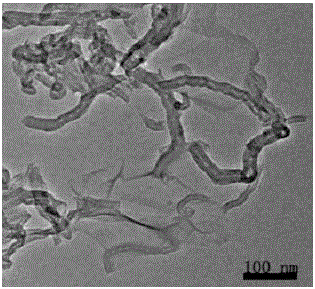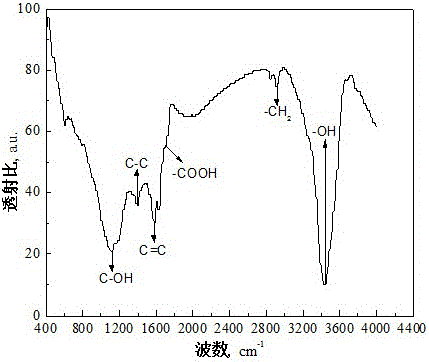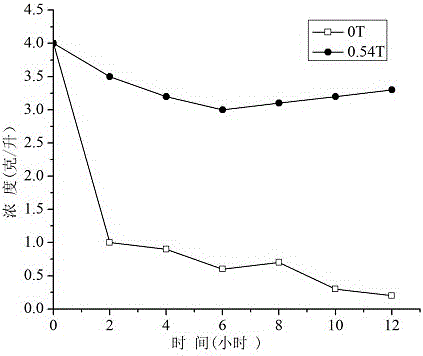Method capable of removing limescale and heavy metal ions in water
A heavy metal ion and water removal technology, which is applied in the field of water treatment, can solve the problems of graphene and carbon nanotube agglomeration, low order arrangement of carbon nanotubes, and weak adsorption capacity of graphene/carbon nanotube composite materials. Achieve good adsorption capacity, mild conditions, and easy operation
- Summary
- Abstract
- Description
- Claims
- Application Information
AI Technical Summary
Problems solved by technology
Method used
Image
Examples
Embodiment 1
[0034] Step 1 Pretreatment of carbon nanotubes:
[0035] Disperse 1g of original multi-walled carbon nanotubes (prepared by chemical vapor deposition) into a mixed acid solution consisting of 30ml of concentrated sulfuric acid and 10ml of concentrated nitric acid, stir and react at 60°C for 3 hours, wash with distilled water until neutral, and dry in vacuum at 80°C Reserve after 12 hours.
[0036] The preparation of step 2 graphene oxide:
[0037] Take 2g of natural flake graphite with an electronic balance, use a graduated cylinder to measure 46ml of concentrated sulfuric acid and pour it into a 1000ml three-neck bottle, cool to 0~5°C, add the weighed 2g of graphite to 46ml of concentrated sulfuric acid, Use an ice bath to cool to 0~5°C and stir until the graphite is completely dissolved, add 1g of sodium nitrate and 6g of potassium permanganate at a certain speed while stirring vigorously, keep the temperature of the mixture below 10°C and continue stirring for 2.5 hours; r...
Embodiment 2
[0044] Step 1 Pretreatment of carbon nanotubes:
[0045] Disperse 2 g of original multi-walled carbon nanotubes (prepared by chemical vapor deposition) into a mixed acid solution of 60 ml of concentrated sulfuric acid and 20 ml of concentrated nitric acid, stir and react at 60°C for 3 hours, wash with distilled water until neutral, and dry in vacuum at 80°C for 12 Stand by after hours.
[0046] The preparation of step 2 graphene oxide:
[0047] Take 4g of natural flake graphite with an electronic balance, use a measuring cylinder to measure 92ml of concentrated sulfuric acid and pour it into a 1000ml three-neck bottle, cool to 0~5°C, add the weighed 4g of natural graphite into 92ml of concentrated sulfuric acid , use an ice bath to cool to 0~5°C and stir until the graphite is completely dissolved, add 2g of sodium nitrate and 12g of potassium permanganate at a certain speed while stirring vigorously, keep the temperature of the mixture below 10°C and continue stirring for 2.5...
Embodiment 3
[0054] Step 1 Pretreatment of carbon nanotubes:
[0055] Disperse 0.5g of original multi-walled carbon nanotubes (prepared by chemical vapor deposition) into a mixed acid solution of 15ml of concentrated sulfuric acid and 5ml of concentrated nitric acid, stir and react at 60°C for 3 hours, wash with distilled water until neutral, and dry in vacuum at 80°C Reserve after 12 hours.
[0056] The preparation of step 2 graphene oxide:
[0057] Use an electronic balance to take 2g of natural flake graphite, use a graduated cylinder to measure 46ml of concentrated sulfuric acid and pour it into a 1000ml three-neck bottle, cool to 0~5°C, add the weighed 2g of natural graphite to 92ml of concentrated sulfuric acid , use an ice bath to cool to 0~5°C and stir until the graphite is completely dissolved, add 2g of sodium nitrate and 12g of potassium permanganate at a certain speed while stirring vigorously, keep the temperature of the mixture below 10°C and continue stirring for 2.5 hours;...
PUM
| Property | Measurement | Unit |
|---|---|---|
| quality score | aaaaa | aaaaa |
Abstract
Description
Claims
Application Information
 Login to View More
Login to View More - R&D
- Intellectual Property
- Life Sciences
- Materials
- Tech Scout
- Unparalleled Data Quality
- Higher Quality Content
- 60% Fewer Hallucinations
Browse by: Latest US Patents, China's latest patents, Technical Efficacy Thesaurus, Application Domain, Technology Topic, Popular Technical Reports.
© 2025 PatSnap. All rights reserved.Legal|Privacy policy|Modern Slavery Act Transparency Statement|Sitemap|About US| Contact US: help@patsnap.com



